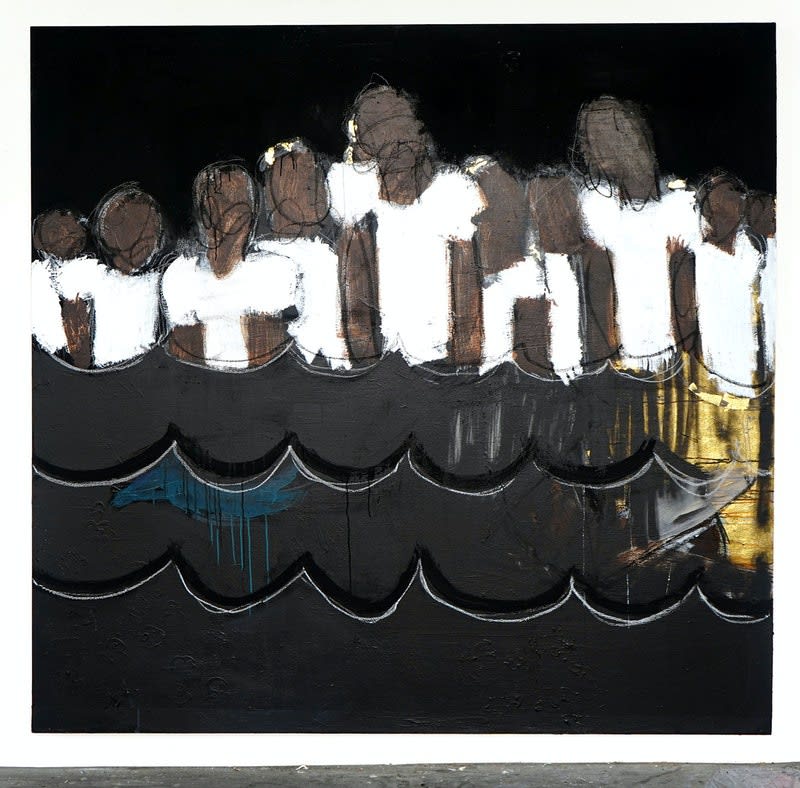By Yxta Maya Murray
In Ferrari Sheppard’s beguiling painting Waves (all paintings 2020), nine Black girls wearing white dresses stand together in the ocean. From the pale color of the sky, it appears to be midday. Their faces are blurred, and their shoulders are hunched, perhaps from the cold; their arms press tightly to their sides. The blue water mounts to their waists in clear, pointed waves composed of layers of baby blue and indigo. A stripe of gold leaf extends across the bottom of the canvas, like sand, or a precious hidden underworld. In a companion piece, Oxide, we find the girls again, later in the night. They remain in place as the now-black waves continue to lap at their bodies. The gold has shifted from the bottom of the canvas to a glistening smear across a patch of water, maybe reflecting the sun as it descends. Do these two paintings describe, in time-lapse, a wonderful day at the beach? And if so, why is something oxidizing in the latter painting, if that chemical reaction always results in loss and erosion?
Questions like these arise in Heroines of Innocence, Sheppard’s complex and ambitious show at Wilding Cran. Sheppard, born in Chicago, raised for a time in New York, and now based in Los Angeles, has a multivalent practice. He has produced songs for the group Dec 99th and worked as a music journalist and travel correspondent. Having attended the School of the Art Institute of Chicago, he brings his formidable intellect and passionate engagement to this series of acrylic, charcoal, and gold-leaf portraits of Black girls and women spending time together and offering themselves moments of contemplation or repose. Sheppard constructs these figures out of kinetic bursts of color, scrabbles of charcoal stick, and weeping drips of paint. While one worries that his images of women seabathing and childrearing will be read as multicultural updates of Mary Cassatt’s Madonna-child idylls or Berthe Morisot’s glass-gazing ladies, Sheppard employs radical sfumato, scrawls, leaks, a patchy or unfinished touch, and evocative titles to alert the viewer to his deeper meanings.
Such is the case, for example, with Magnetite, a portrayal of five girls, again in white dresses, forming a ring-around-the-rosie circle. They reach their arms toward each other and gold leaf graces their fingertips and necks. A deep black sky looms above them, indicating that night has fallen, and driblets of white paint fall from their shoes. Maybe the girls have been playing with such abandon that they failed to notice that it was dinnertime, and this painting celebrates the form of resistance that thinkers such as Kleaver Cruz describe as “Black joy.” Indeed, joy does exist in the painting—the gold glistens on the fingertips that extend to touch a friend. But a look to the title of the piece indicates that troubling emotions also wander into the scene, as magnetite is an astonishing triple substance, being magnetic iron ore, a material that is manufactured in a region of the brain associated with the development of memory, and a toxin: Magnetite reminds us that BIPOC people are brought together by a history that can help create culture and love, but that those same memories could also potentially kill us.
In Bond, a mother holds her infant child with great gentleness. The fears that may waft from Waves and Oxide do not seem as present here, particularly at first glance. A rejoicing emanates from the painting, as the mother bends her head toward her baby, and the baby itself is made of patches of gold leaf. The mother and child are composed of great dashes and hectic circles; Sheppard limns the mother’s hands so energetically that they look almost like scratches. The baby’s gold aura resonates within busy, messy outline sketches, so that we observe its body less than its radiant soul. In Paka (Cat), Sheppard continues to experiment with this kind of creation that verges on a dismantling. Here, he depicts an assured woman who sits on a chair that is both a gold throne and a vanity, while her gato watches on adoringly. Her hands delicately touch her body but also pour with loose paint, which dribbles down to the bottom of the canvas. Her breasts are designated by a huge, curly W, and more drips fall from her foot, her elbow, and the cat, as if we glimpsed her through a rain-splattered window. And in The Promise, a woman wearing a white dress and holding her infant child wanders past a lake where half-painted trees and bushes swirl and spatter in the background. Like in Bond, she stares down at her child and clutches the baby close. And like Paka (Cat) and Magnetite, her feet seep paint and threaten to come undone.
In an essay accompanying Wilding Cran’s exhibition materials, Kristina Kay Robinson reminds us (via Fred Moten) that any theory of aesthetics or ethics must begin with an “imagin[ing] of night time for the newly captured … [and fashioned] by contending with the expressions of the oppressed.” Looking at Sheppard’s work, we are made also to think of Walter Mignolo’s observation that “What decolonial artists want is not to create beautiful objects … but to create in order to decolonize sensibilities.” Sheppard conjures spaces where love, beauty, family, connection, play, harmony, and freedom exist, and are built with the tenacity and vibrancy that exists in the face of racist destruction and collapse. He reveals how these moments of tenderness and union must be wrenched from the forces of white supremacy, that sterile and ravenous brand of death.




